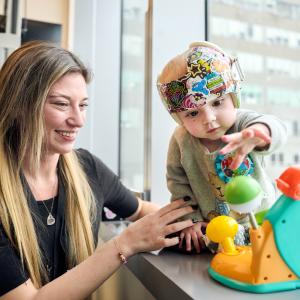NYU Winthrop and NYU Langone have teamed up to develop new methods for diagnosing congenital heart defects in children. Martin Chavez, MD, chief of the Division of Maternal–Fetal Medicine at NYU Winthrop Hospital, and James C. Nielsen, MD, associate director of the Division of Pediatric Cardiology at NYU Langone, are utilizing pediatric cardiac MRIs and fetal ultrasound technology to detect issues early on in pregnancy.
Dr. Nielsen, a pediatric cardiologist, is skilled in utilizing these diagnostic tests to detect holes in the heart, abnormal heart chambers, inflammation of heart muscle, and more. “Cardiac MRI for congenital and pediatric heart disease has become an essential tool for clinical centers of excellence,” says Dr. Nielsen. “Cardiac disease in children is much different than adult heart disease, and special tools and expertise are needed.”
An echocardiogram is a standard diagnostic tool to confirm congenital heart defects, especially in young children. Using sound waves to create pictures of the heart’s chambers, valves, walls, and blood vessels, including the aorta, an echocardiogram can help diagnosis about 90 percent of patients. A cardiac MRI, especially when utilized for diagnosing older children with congenital heart defects, provides important information regarding the heart’s anatomy, and function.
“A child’s heart rate is much faster, and the heart conditions are unique, so we have to modify the way we obtain and interpret images of the heart,” explains Dr. Nielsen. “The heart is moving fast, which is a big challenge. It’s not like taking a portrait photo, it’s as though we’re taking a picture of a sprinter, and one needs to optimize the camera’s shutter speed. Years of experience, and deep understanding of both the MRI machine, and children’s heart diseases are essential for success.”
The heart of an unborn baby poses its own set of challenges, so Dr. Nielsen and Dr. Chavez set out to develop an early fetal cardiology program. “We were looking for additional ways to advance our field,” says Dr. Chavez. “We had the right resources, technologies, and our interests were aligned.”
Fetal heart issues are typically found between 18 and 22 weeks of pregnancy but Dr. Nielsen and Dr. Chavez wanted to detect concerns even earlier, at 11 or 12 weeks. They decided on a combination approach of transabdominal ultrasound, a standard of care in pregnancy, along with a transvaginal ultrasound which is less typical. Traditional imaging produced pictures but since the heart measures about one centimeter in diameter at this stage of pregnancy, the transvaginal approach detected the sound waves more clearly. “There are a few centers in the U.S. utilizing this new protocol, but NYU Winthrop is certainly among the first in the New York metro region,” says Dr. Chavez.
A recent NYU Winthrop patient, who had lost her first baby to heart disease, soon become pregnant again. She received testing in her first trimester, and when she learned the baby had no congenital heart defects, “An enormous burden had been lifted from her shoulders,” describes Dr. Chavez. “She said she could now enjoy her pregnancy, as so many other women do, without fear of a catastrophic outcome.”
Dr. Chavez and Dr. Nielsen are now exploring how to share their groundbreaking approach on video in order to enhance the testing experience, and diagnostic capabilities.

